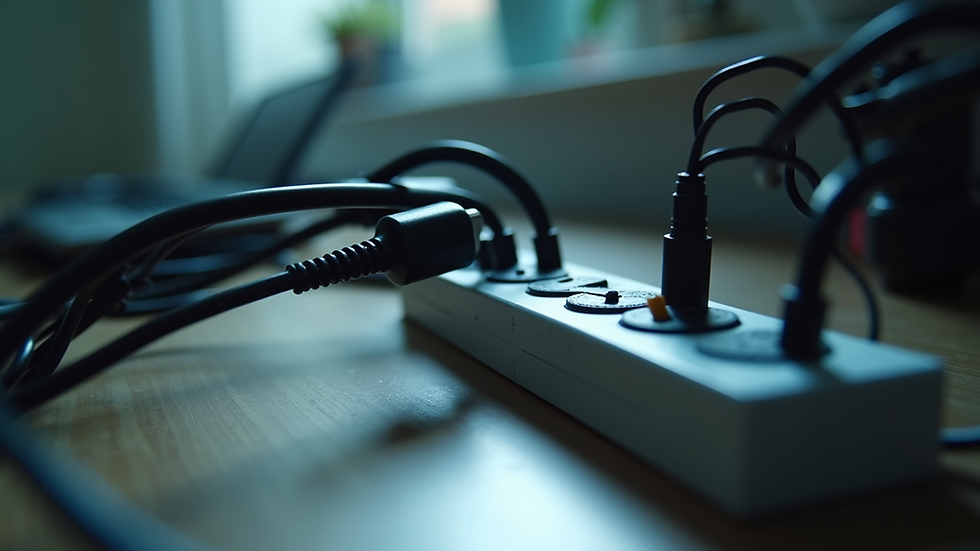The Hidden Risks of Overusing Extension Cords You Didn’t Know About Pro Max Electrical-Houston
- Ruben Esquivel
- May 25
- 4 min read
Extension cords are often the unsung heroes of our home and work lives. Whether it's powering a holiday light display, extending your workspace, or simply accommodating that extra appliance, these cords provide a convenience that many of us depend on daily. However, lurking behind this convenience are some pretty significant risks that can lead to hazards if not handled properly. Let's dive into why overusing extension cords can create serious problems, including voltage drops and long-term risks.
Understanding Extension Cords
At their core, extension cords are designed to carry electricity from a power source to an appliance. They come in various lengths and gauges, allowing for a range of uses. However, the more you stretch your circuit with long or multiple extension cords, the more you may be exposing yourself to danger.
Extension cords are typically rated for short-term use. They aren't meant to be a permanent solution for getting power to devices that are far away. When used beyond their intended capacity or for permanent setups, you can encounter various electrical issues that can lead to fires, equipment damage, or even personal injury.
The Risks of Voltage Drop
One of the most insidious issues with overusing extension cords is the phenomenon known as voltage drop. When electricity travels through a wire, some energy is lost as heat due to the resistance of the wire. The longer the wire (or cord), the greater the resistance, and consequently, the more significant the voltage drop. This can lead to appliances not receiving enough power to operate correctly.
Consequences of Voltage Drop
When an appliance doesn’t receive the voltage it requires, it can underperform or fail entirely. For example, motors in tools or appliances may overheat, leading to shortened lifespans or catastrophic failures. In some cases, this can even cause electric shocks or sparks, leading to fire hazards.

Rating and Usage of Extension Cords
Every extension cord comes with a rating that indicates its safe usage, usually measured in amps. Many people make the mistake of using a light-duty cord for high-demand applications. This is a recipe for disaster. Overloading a cord can lead to overheating and, ultimately, fire.
Moreover, if you are constantly plugging in and out or using multiple cords to reach your devices, you are exacerbating the risk. Each extension introduces potential failure points in the circuit, from connections that can loosen over time to deteriorating insulation.
Recognizing the Signs of Overuse
Identifying whether you are overusing an extension cord is crucial. Here are some tell-tale signs:
The cord feels warm to the touch.
You hear a buzzing noise when using the appliance.
Flickering lights when the device is plugged in.
If you encounter any of these issues, it’s a warning signal to reduce your usage of extension cords or switch to a more permanent solution.
Long-Term Use is Not Recommended
While it might be tempting to use an extension cord as a long-term fixture—especially in a less permanent setup—experts strongly advise against it. The insulative materials degrade over time, which can lead to exposed wires and short circuits.
Moreover, unlike hardwired setups that have proper ratings and protections, extension cords lack necessary safeguards. As a result, using them for prolonged periods puts you at increased risk.

Best Practices for Safe Extension Cord Use
To minimize risks associated with extension cords, consider the following best practices:
Choose the Right Cord: Match the extension cord rating with the appliances you intend to use. Heavy-duty appliances require heavy-duty cords.
Limit Length: Use the shortest extension cord necessary to minimize resistance and potential voltage drop.
Avoid Daisy-Chaining: Connecting multiple extension cords can compound risks. Always try to use one high-quality extension cord instead.
Inspect Regularly: Check your cords for frays, cracks, or any signs of wear. Replace any damaged cords immediately.
Disconnect When Not in Use: Inserting a cord and forgetting about it can lead to unaccounted risks. Unplug items when you’re not actively using them.
Use Permanent Solutions When Possible: If cords are a frequent part of your setup, consider investing in hard-wiring or installing more outlets.
The Bottom Line on Extension Cords
So, while extension cords might be a quick fix for many electrical needs, their convenience comes at a risk. Voltage drop and long-term usability concerns can lead to dangerous situations. Understanding the proper use, limitations, and risks is essential for keeping your home and workspaces safe.

Conclusion
In a world where convenience is key, it’s easy to overlook the hidden dangers of extension cords. By understanding the consequences of overextending circuits and the risks associated with long-term use, you can protect yourself, your loved ones, and your property from potential electrical hazards. Embrace safe practices, and when in doubt, always opt for solutions that meet safety standards and regulations. After all, when it comes to electricity, a little caution goes a long way!









Comments